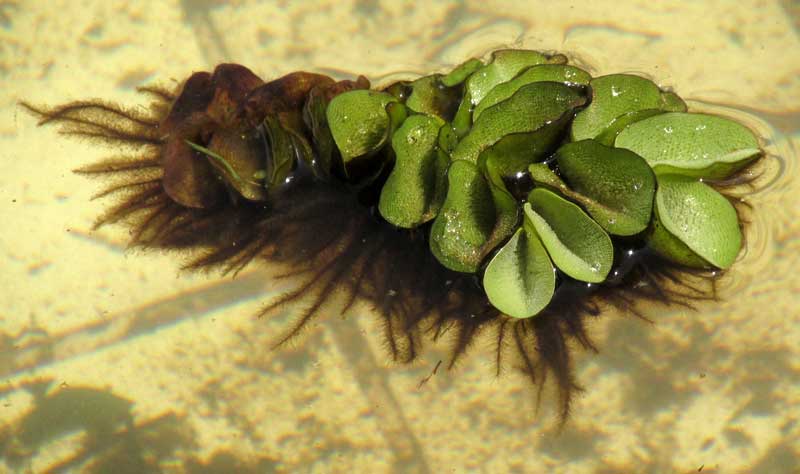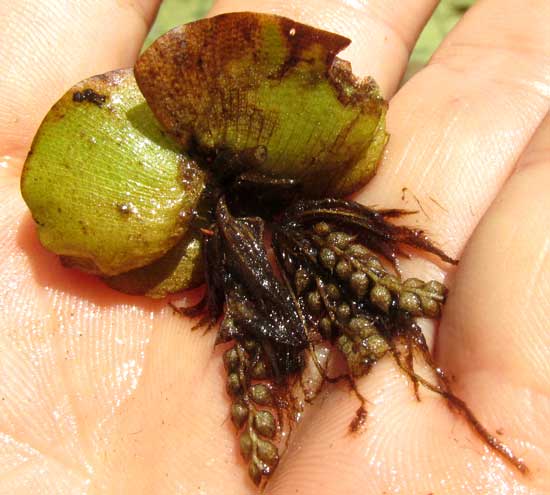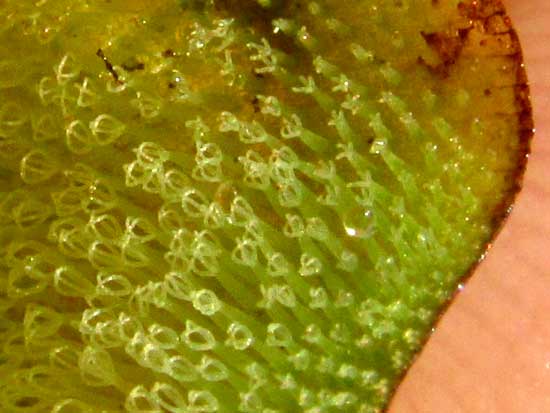Excerpts from Jim Conrad's
Naturalist Newsletter
from the November 19, 2017 Newsletter, with notes taken in mid October near Tepotzlán, Morelos state, MÉXICO
Elevation about 5315 ft (1620m), at 18°59′07″N 99°05′59″W
AQUATIC GIANT SALVINIA
During my mid-October visit with a friend near Tepotzlán, Morelos, in the uplands just south of Mexico City, one of the most interesting finds turned up in a little fishpond with waterlilies and other aquatic plants. Below, you can see it floating atop the pool's clear water:

This is one of those plants that if someone during your life doesn't just tell you what it is, you may never identify it on your own. That's because it doesn't flower or fruit, and the vegetative parts are simply unlike anything else. However, if you're lucky -- as I was during my visit -- and you look long enough, you may see some chain-like structures dangling into the water from beneath the floating blades, such as those shown below:

The brown, oval items in that picture are "sporocarps," which normally contain spores or spore-cases containing spores. That explains why the plant never produces flowers or fruits, because it's a fern, and each of the green blades floating on the water is a floating frond. Many years ago in the Climatron of St. Louis's Missouri Botanical Garden, where I worked, I learned that this kind of plant belongs to the small Salvinia Family of ferns, the Salviniaceae, and that it's the genus Salvinia.
Several Salvinia species are recognized, and it can be hard to distinguish them. However, within the genus there's a cluster of closely related, very similar species referred to as the Salvinia auriculata complex, and that complex is easy to recognized because species belonging to it all have "eggbeater-shaped hairs" covering their fronds' upper surfaces. If you can't visualize eggbeater-shaped hairs, take a look below:

That's a close-up of the top of one of the fronds floating in my friend's pool, so we know we have a member of the Salvinia auriculata complex, because other Salvinia species don't produce eggbeater-shaped hairs.
Species belonging to the Salvinia auriculata complex are Salvinia auriculata, S. biloba, S.herzogii and Salvinia molesta. Working with just my pictures I can't be sure which species we have here, but of those four species only Salvinia molesta is described as "notorious and widespread," and much used as an ornamental aquarium plant, so I'm guessing that that's what we have.
SALVINIA MOLESTA, then, often called Giant Salvinia, is native to southeastern Brazil and northern Argentina. The IDTools.Org page for Giant Salvinia describes it as a sterile hybrid. The online Flora of North America describes the species as of hybrid origin, and says that its sporocarps contain mostly empty sporangia, or spore cases. If present , any spores are deformed.
Therefore, Giant Salvinia reproduces vegetatively. Frond-forming buds develop at stem nodes, and stem fragments are dispersed by wind, water currents, and human activities such as boating. This vegetative reproduction is so effective that in much of the world's tropics and semi-tropics Giant Salvinia is a serious aquatic weed clogging slow-moving, nutrient-rich, freshwater ditches, canals, ponds, lakes and rivers throughout the world's tropics and semitropics. Giant Salvinia was added to the IUCN List of 100 of the World's Worse Invasive Alien Species in 2013.
I read that six-ft-deep (2m) mats of Giant Salvinia can form atop water, blocking light entering the water, and reducing the water's oxygen content, thus seriously impacting the water's native plants and animals. Fortunately, a little Salvinia-eating beetle called Cyrtobagous salviniae is used successfully in the biological control of Giant Salvinia.